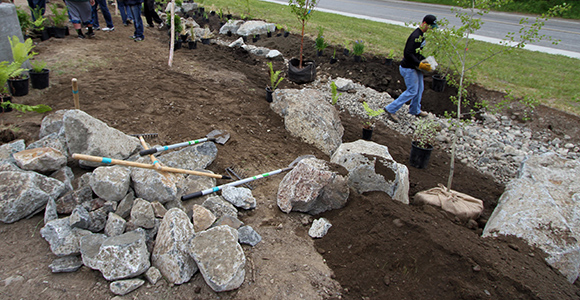
Commercial site rain garden installation (Photo: U.S. Fish & Wildlife)
At the 2016 California Economic Summit in Sacramento, participants asked a simple question, “How could the business community contribute to the One Million Acre-feet Challenge?”
From there, four organizations partnered to explore how regions could align programs for watershed sustainability:
- The Pacific Institute, a global leader in water resources research and policy.
- The Santa Ana Watershed Project Authority, a statewide leader in integrated water management.
- The CEO Water Mandate, a United Nations Global Compact commitment platform that mobilizes business leaders to address global water challenges through corporate water stewardship.
- CA Fwd and its team supporting the Summit’s One Million Acre-feet Challenge.
Last week, the partners released a report on the opportunities to capture and conserve water on commercial and industrial properties in the Santa Ana Watershed.
Sustainable Landscapes on Commercial and Industrial Properties in the Santa Ana River Watershed explores how landscape conversion on commercial and industrial properties can reduce water use, increase stormwater capture and groundwater recharge, improve water quality, and reduce greenhouse gas emissions and pesticide use.
The commercial and industrial parcels in the Santa Ana River Watershed are adorned with nearly 10,000 acres of irrigated turf and more than 22,000 acres are irrigated in some way. Another 158,000 acres are covered by impervious surfaces.
- Approximately 70 percent of these parcels are within subwatersheds with impaired waterbodies.
- Approximately 29 percent of these parcels are within 100- and 500-year flood zones.
- Approximately 55,000 acres are suitable for groundwater infiltration and recharge.
- An additional 90,000 acres overlay groundwater areas are suitable for stormwater capture and onsite reuse.
Converting existing commercial and industrial landscapes to sustainable landscapes can provide substantial sustainability benefits for the region. For example, reducing water use by 55 percent on 10,000 acres of irrigated turf (roughly equivalent to recent state requirements for new commercial and industrial landscaping) would save almost 21,000 acre-feet of water per year. The conversions also can help reduce flooding and pollution while recharging groundwater.
The report also evaluated the business community’s motivations and challenges. The report identifies eight strategies to develop programs and policies that effectively encourage businesses to act:
- Develop resources to assist businesses considering sustainable landscape improvements.
- Use language and examples that resonate with the business community.
- Develop appropriate incentive programs and policies.
- Develop targeted financial incentive programs.
- Foster long-term relationships between water managers and the business community.
- Streamline approval and permitting process.
- Explore alternative funding sources.
- Coordinate policies and programs across the watershed.
“Business and civic leaders are ready to take action to make our communities and watersheds more sustainable and resilient. This report illuminates a path forward for multi-benefit landscape investments to support these goals,” said Jim Mayer, CEO of CA Fwd.
The One Million Acre-feet Challenge seeks advance state and regional policies and actions to capture, conserve, and reuse one million acre-feet of water each year for the next 10 years to close the gap between available supplies and the needs of people, business, agriculture, and the environment.

